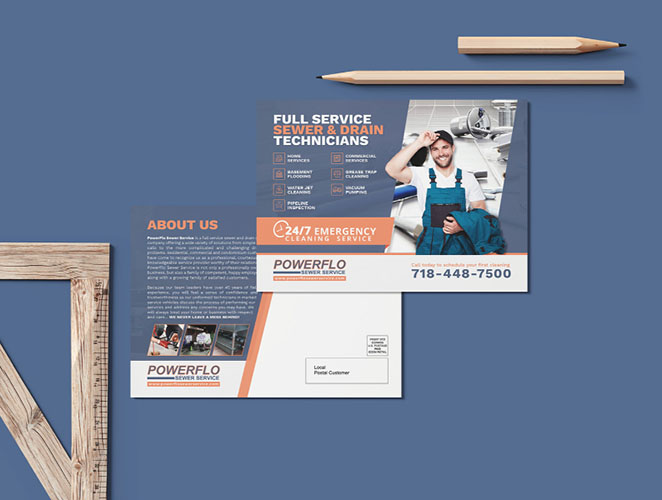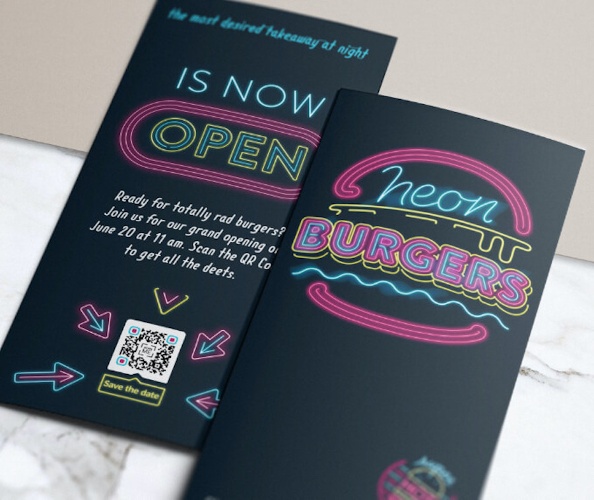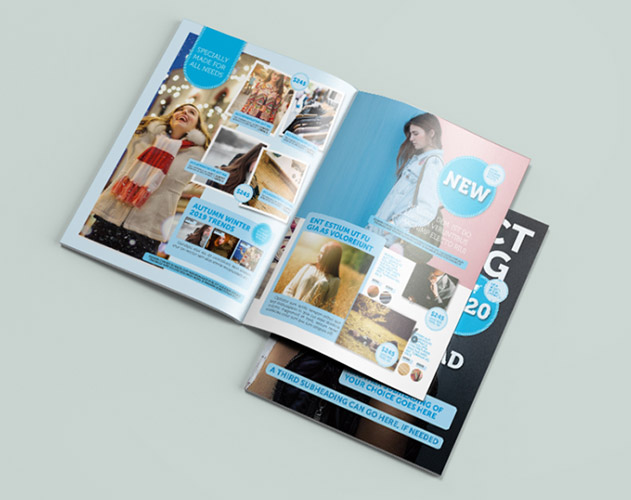A direct mail campaign is any printed marketing or advertising material sent to physical mailing addresses. It’s a highly effective, cost-efficient way to reach a list or locale-based audience, and it’s easy to track your return on investment (ROI). In this article, we explore how to run a direct mail marketing campaign and the different types of campaigns you can try.
Direct Mail Marketing Overview & Examples
You’ve likely received hundreds of direct mail marketing campaigns in the form of postcards, flyers, brochures, or more. Direct mail advertising campaigns offer a more direct and tangible medium to connect with audiences, and they’re effective for increasing brand awareness and boosting engagement and conversions. Combining direct mail marketing with email or other digital marketing in a coordinated campaign can magnify the effectiveness of both media.
Key takeaway: Direct mail involves sending printed marketing materials to physical residential or business addresses. They can be used in nearly every stage of the marketing funnel, from boosting brand presence to generating leads or sales. They’re also notably effective—74% of marketers found direct mail marketing to be even more effective than email.
Check out some examples of direct mail marketing campaigns below:
Pro tip: Looking for more examples of direct mail campaigns (plus design inspiration)? Check out our list of 20 direct mail ideas.
Key Components of a Direct Mail Campaign
To better understand what marketing direct mail is, it’s crucial to know the different stages of launching a mailing campaign. The actual printed mailer you send out is an important aspect, but equally significant to your success are your mailing list and content, among others. Here are the essential elements to take note of when creating a direct mail marketing campaign:
- Campaign objective: Every marketing campaign should have a main objective. For direct mail campaigns, your objective is the main focal point that all other campaign elements, such as your call to action (CTA) and format, will revolve around. Your objective can be anything from brand awareness to getting more people to your store, more visitors to your website, increasing buying frequency, getting referrals, and more.
- Audience: Your desired audience plays a key role in your campaign and will depend on your primary objective. For example, if your objective is to increase sales of a new product, your mailing list could include previous customers of your business. Or, if you’re looking to tap into a new market, you might target recipients in a certain region using an Every Door Direct Mail (EDDM) campaign.
- Mailer content: Your mailer’s content encompasses your message and the value you offer to recipients. It’ll also depend on your objective—if your aim is brand awareness, your content will likely only include information. On the other hand, if you want to increase sales, you might include a discount offer or other promotion and include a smartphone-scannable quick response code (aka QR code) to take customers to a landing page.
- Mailer design: Your mailer needs to stand out from dozens of others in your recipient’s mailbox, and the best way to do that is with good, eye-catching design. One of the best things about direct mail marketing is that you can be as creative as you want (within the bounds of your brand style, of course)—experiment with fonts, layouts, and colors to really make a strong first impression.
- Mailer format: There are dozens of formats, from brochures and coupons to free samples and brand kits—the limits are nearly endless, as long as they can be sent via postal mail. Postcards and flyers are generally used for short messages, while brochures are great for in-depth information. Dimensional mailers use creative folding, slide-out, or pop-up elements to engage your recipient and have a very high open rate.
- Delivery service: Finally, you’ll also need to choose a delivery service to send your mail to your recipients. The US Postal Service (USPS) is the most common and cost-effective option. You can handle design, postage, and mailing yourself, but an easier process is to partner with a direct mail service like VistaPrint or PostcardMania. They do all the delivery work for you, and some even offer templates, online design tools, and printing services for your mail campaigns.
Types of Direct Mail Marketing Campaigns
With direct mail marketing, the options are nearly limitless. You can carry out almost any type of advertising campaign and show impressive results, whether you’re launching a new product or trying to win back lapsed customers. Here are some of the most popular types of direct mail campaigns used by direct mail marketers to consider, depending on your type of business and marketing goals.
New Move-in Campaigns

New move-in campaigns are one of the most common for direct mail. (Source: The Addressers)
New move-in campaigns are targeted specifically at people new to a geographical area and are focused on increasing brand awareness and acquiring new customers. They’re often used by businesses such as medical and dental practices, insurance agents, contractors, and others to introduce their local services and create a starting point for long-term relationships. Mailing lists are often compiled by looking at recently sold properties throughout a business’s service area.
New Customer Offer Campaigns
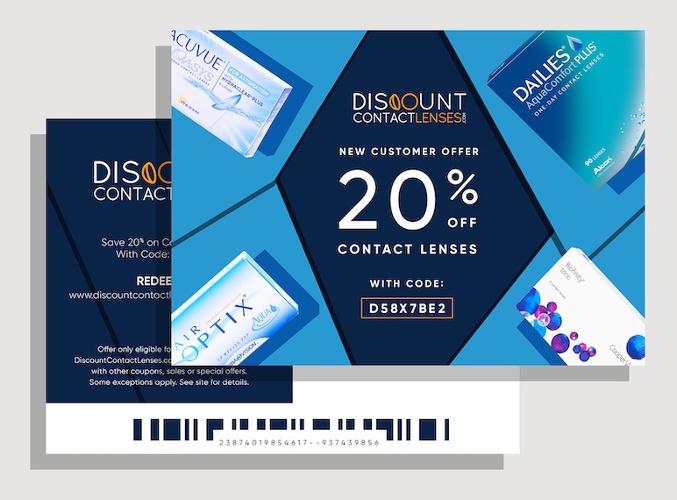
New customer offers aren’t limited just to new move-in residents in an area. They can be sent out to anyone who isn’t yet a customer of your business. You can, however, target recipients by location, demographic, behavior, or interest. New customer offer campaigns usually include an incentive such as a first-purchase discount or a free delivery coupon, among others.
Designing an effective coupon offer requires a compelling offer as well as persuasive copy and impactful graphics. Check out our list of coupon examples and ideas for inspiration. Each one offers insights into how to create new customer offers that will stand out in recipients’ mailboxes and get redeemed.
Brand Awareness Campaigns
Brand awareness campaigns are some of the most versatile campaigns you can do with direct mail marketing. Because your primary goal is to make an impression and let people know your brand, you can be as creative and bold as you like and use any direct mail format available. Some of the most well-established are product catalogs, free samples, and creative brochures.
While trifold brochures might be the first format that comes to mind, you’re not limited to that style. In fact, we found more than 20 of the best brochure examples for small businesses in a variety of shapes, sizes, and designs.
Brand awareness campaigns focus on putting your brand top-of-mind for consumers with direct response as a secondary goal. Therefore, it’s good to follow up brand awareness campaigns with other types of initiatives. For example, you could start with a new move-in mailer, then send a brand awareness mailer, and follow that up with a new customer offer as part of a drip campaign.
Reengagement Campaigns
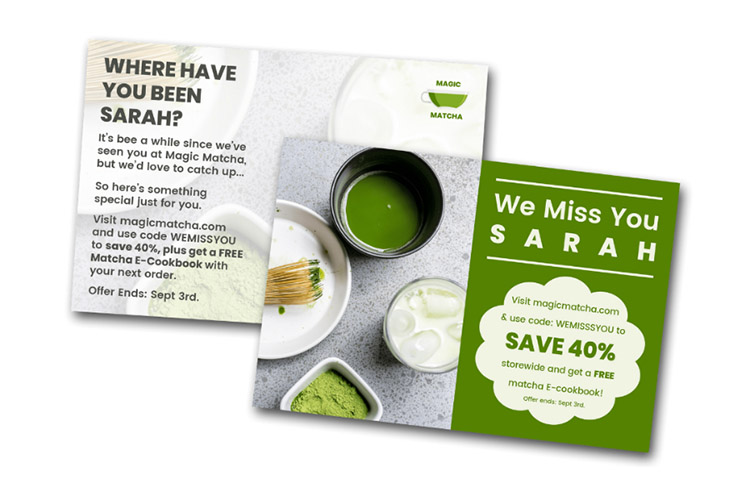
You probably know reengagement campaigns best as “we miss you” mailers. They are meant to entice old or inactive customers to engage with your business again, usually with the help of an incentive. While reengagement campaigns aren’t unique to direct mail (you’ll find many of them on email), physical mail adds a more authentic and personal touch. For even more impact, use both email and physical reengagement campaigns.
Loyalty Campaigns
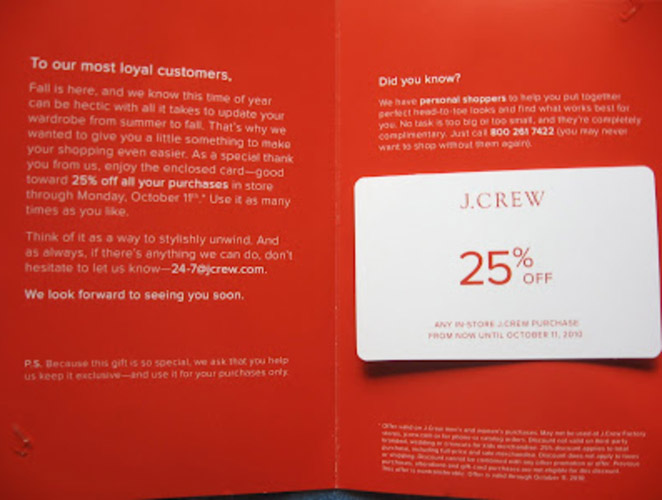
Branding statistics show that one loyal customer is worth 10 times as many one-time customers in terms of profitability. This makes retention more cost-effective than acquisition. Direct mail marketing not only works great for gaining new customers and boosting brand awareness, but is also effective for fostering brand loyalty with existing customers. Brand loyalty campaigns are a great avenue for personalization—you can customize your messaging and design, often including their name, to make your most loyal customers feel valued and appreciated, and offer them a special gift or discount as an extra incentive.
Special Occasion Campaigns
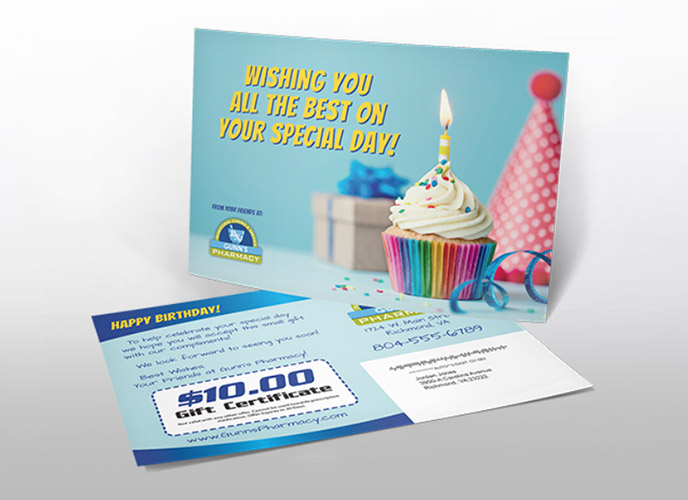
Celebrate your loyal customers’ special occasions with customized direct mail. (Source: Conquest Graphics)
Everybody loves receiving presents on special occasions, which is what makes special occasion campaigns so effective. Sure, you can send an email to celebrate a loyal customer’s birthday or anniversary, but nothing compares to the tactile feel of receiving something tangible on your special day.
Since special occasion campaigns are inherently personalized (instead of mass-delivered), maximize their impact by taking the time to customize your messaging and design. And, of course, offer a gift as a token of appreciation—this could be anything from a discount code to bigger packages like gift boxes or branded cookies. The extra bit of effort could potentially gain you a lifelong customer.
Reminder Campaigns
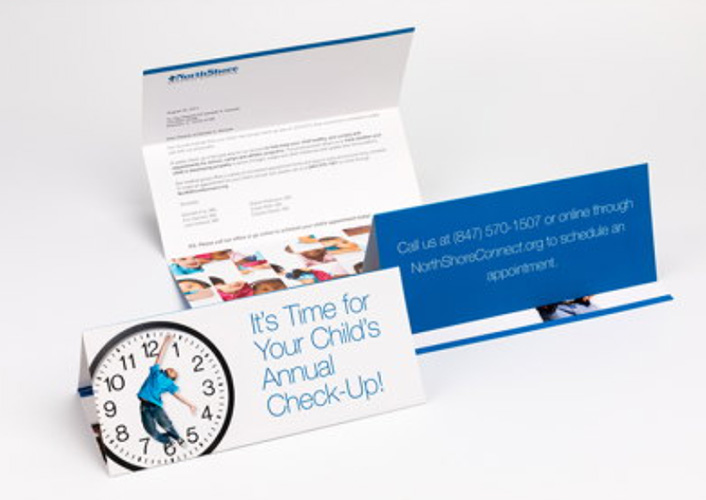
Reminder direct mail campaigns are a great way to keep your customers engaged and your brand top-of-mind. They’re best suited for businesses with upcoming appointments or events, but they also work as a marketing tactic to gently reengage customers with your business, similar to reengagement campaigns.
When creating reminder campaigns, be sure to stay polite and friendly—you don’t want to leave your recipients with a negative impression by using the wrong tone or seeming pushy. Keep your messaging simple, considerate, and to the point.
Drip Marketing Campaigns

Drip marketing is a step-by-step approach to increasing your sales by systematically guiding customers through every stage of the sales funnel, following a set of conditions based on customer behavior. Often, a drip campaign starts with a brand awareness piece, possibly followed by more in-depth product information and then more of a CTA-driven piece.
While you can do drip marketing through email, you’ll be fighting a lot more competition. If you have the budget, sending your drip campaign through regular snail mail adds a degree of authenticity, which could lead to stronger brand loyalty.
Up-sell and Cross-sell
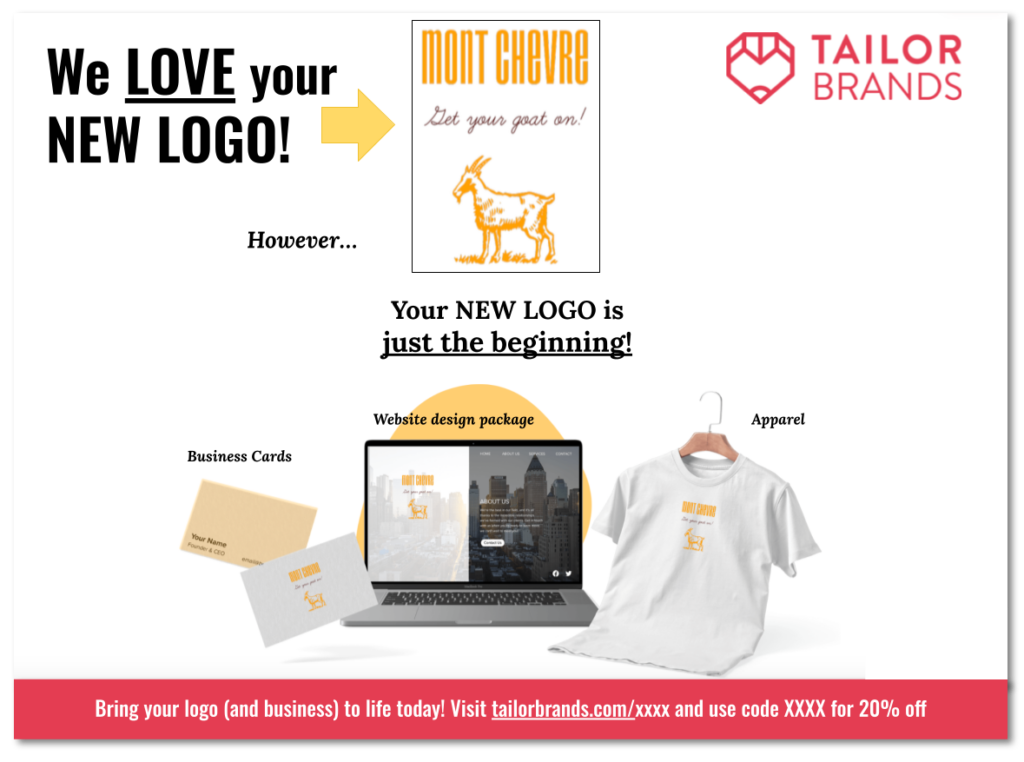
Example of direct mail postcard upselling logo design customers on additional design services and printing
Up-selling is offering a more premium product in your line to enhance or even replace a product the consumer has previously purchased. Cross-selling, on the other hand, offers other products that complement their existing product or are simply under the same brand.
Cross-sell and up-sell are highly effective. According to MARKINBLOG, “the probability of selling to a new prospect is 5%–20%. The probability of selling to an existing customer is 60%–70%.” With direct mail, you can target your customers who recently made their first purchase and guide them to view and purchase similar or superior products.
Benefits of Direct Mail Marketing
There’s a simple reason direct mail remains a well-used local advertising format despite the prominence of all things digital: it is effective on many fronts. Physical mail, brochures, and catalogs have withstood the expanding digital marketing landscape and remain an effective way to get your brand out, as well as gain and retain customers. To better understand what direct mail’s biggest appeal is, check out the stats below.
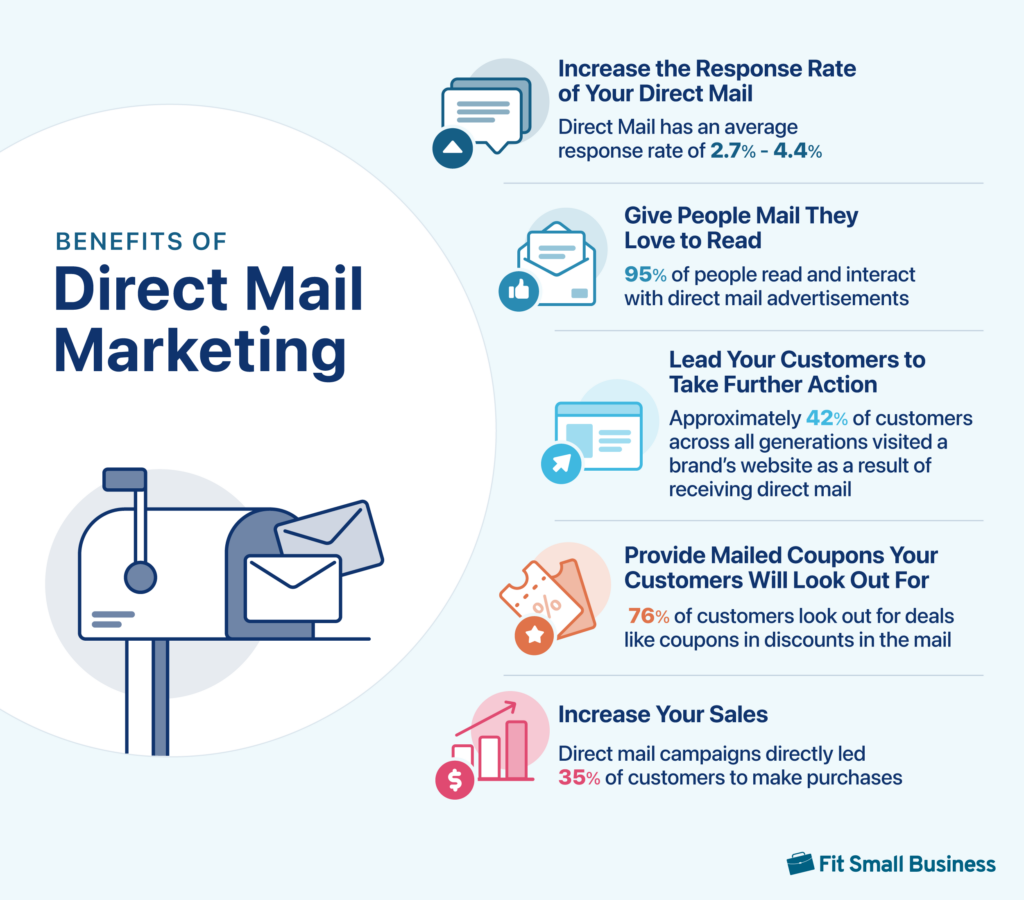
- Direct mails have a great response rate: As of 2024, according to Modern Postcard, marketers might typically expect an average response rate of 2.7%–4.4%.
- People still love reading mail: A study also found that direct mail remains generally popular, with 95% of people reading and interacting with direct mail advertisements in some way. Compared to email, direct mail averaged a 4.4% response rate, compared to a response rate of 0.12% according to Post Analytics.
- They lead customers to take further action: A study by the USPS found that approximately 42% of customers across all generations visited a brand’s website as a result of receiving direct mail.
- Customers look out for mailed coupons: The same study also found that 76% of customers look out for deals like coupons and discounts in the mail and will use them in future purchases.
- They increase your sales: Finally, the study also found that direct mail campaigns directly led 35% of customers to make purchases.
How to Create a Direct Mail Marketing Campaign
Now that you know what a direct mail campaign is, it’s easier to understand how it works and get your first marketing or advertising campaign into the hands of your target audience. There are six steps involved in forming a successful direct mail advertising campaign, from defining your objectives to tracking your results—keep reading to learn more about each.
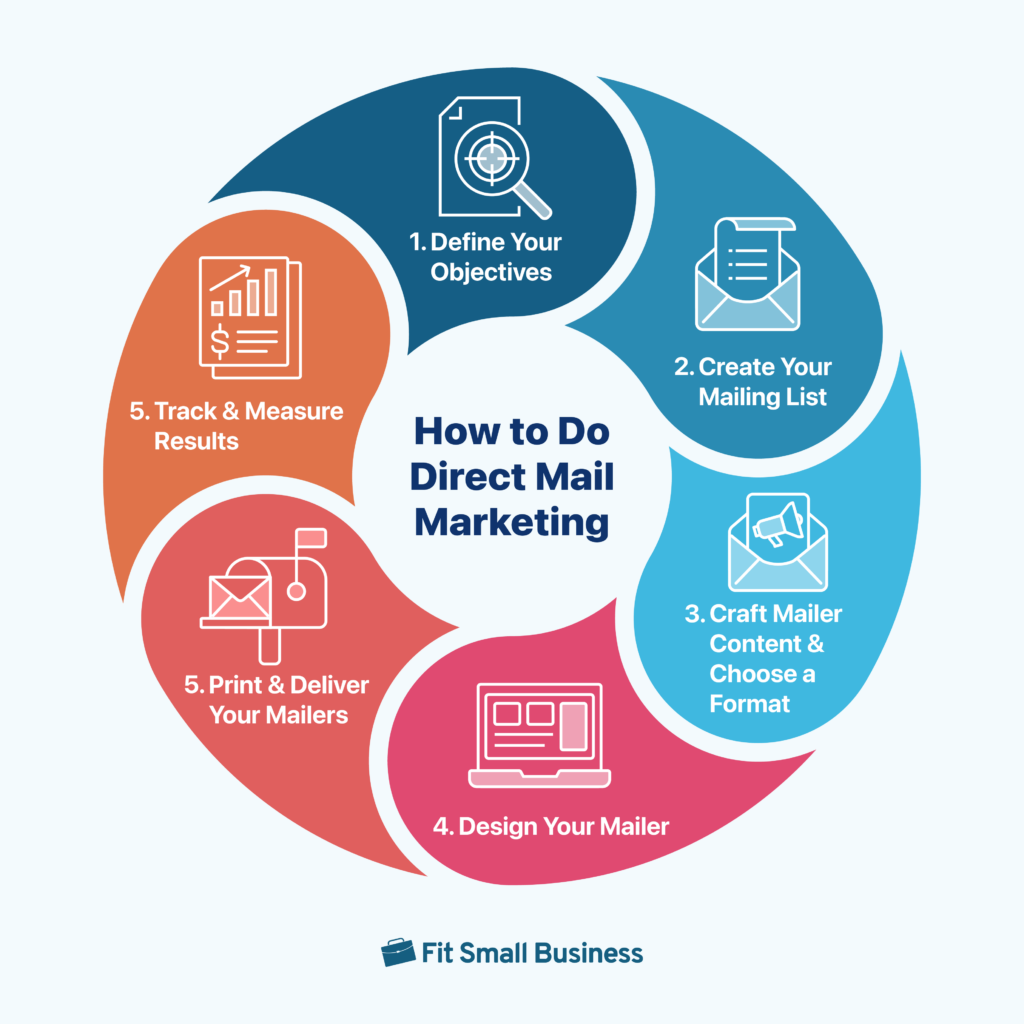
As mentioned above, the first step in forming your campaign is to define your objective. Your objective is the primary goal that your entire campaign will revolve around, whether it’s to educate audiences about your brand or to acquire new customers. It’s also what will define your campaign’s other objectives, including its content, format, and more.
Here are some examples of effective objectives with direct mail marketing:
- Boosting brand awareness
- Increasing sales (especially for a new product)
- Increasing foot traffic to a physical location
- Generating web traffic (and leads)
- Customer engagement and re-engagement
- Generating referrals
- Extending seasonal or limited time offers (LTOs)
- Gaining new customers
After defining your campaign objectives, the second step is to create and define your target mailing list. Unlike email marketing campaigns that can be sent out for free in just a few clicks, direct mail advertising campaigns involve printing and delivery costs, so it’s important not to let a single cent go to waste.
This is why creating a well-defined and up-to-date mailing list is so important—you want to be sure your mails fall into the hands of the people that matter to maximize your ROI. Depending on your marketing objective, create a mailing list of people you want to reach.
- Customer Mailing List: This could be a mailing list you have collected from your customers. For example, if you’re promoting your newest product, you might target your most frequent and loyal customers.
- Compiled Mailing List From Direct Mail Service: If you are casting a wider net, you may purchase an existing list from a company or service tailored to your target audience. These lists are targeted at either consumer, occupant, or business lists.
- Consumer Lists: These lists not only include names and addresses, but are also often enhanced with demographics such as age, gender, educational background, family size, and other factors. The data may also be used to estimate socio-economic profiles as well.
- Occupant Lists: These are the least expensive lists designed to just saturate specific locations by address and are targeted at “resident” or “current occupant” and used by restaurants, dry cleaners, and other local services to cover their service area.
- Business Lists: These lists are segmented by a wide variety of attributes, including geographic area, company size, length of time in business, and other criteria for business-to-business (B2B) targeting, and can be addressed to titles such as “Director of IT” or “Sales Manager.”
- EDDM: Similar to occupant lists, if you want to reach everyone in a given neighborhood with a hyperlocal marketing strategy or everyone within a set per-mile radius from your business, this is a good strategy. Direct mail services like PostcardMania are ideal. They offer super-affordable pricing for EDDM, which delivers your mailer to every address in a given locale.
Once you’ve finalized your mailing list, the next step is to craft your mailer’s content. Whether you’re offering a limited-time discount or just telling recipients about your business, use clear, impactful copy and high-quality images. It’s also a good idea to have a strong CTA that includes elements like your website address, social media page, or a QR code people can scan to visit a landing page. Other examples of valuable elements include coupons or free samples.
Pro tip: When crafting your direct mail content, one thing to keep in mind is to offer value, not just advertising. Give something that your customers will find useful and will want to keep—usually, these are discount coupons or codes, or a small, useful freebie that you can deliver within your budget.
After crafting your mailer’s content, you’ll also need to choose the format it’s best suited for. For instance, to promote a limited-time discount, a simple, well-designed postcard would get the message across the quickest. Meanwhile, trifold brochures can hold lots of information and are thus helpful for telling recipients about your business and brand. Catalogs allow you to communicate many of, or the entire range of, products or services you offer.
But don’t limit yourself to basic mail formats—think of ways outside (or inside) the box to surprise and delight your recipients. Pop-up cards, slide-out messages, and creative multifold brochures that reveal the message in stages are all examples of interesting dimensional mailers. If you need inspiration, check out our list of direct mail ideas to see different options and find out why they work.
Next, you’ll need to design your mailer to ensure that it stands out—and stays out of the recycle bin for as long as possible. Dozens of online design platforms are available to easily design professional and eye-catching direct mail pieces, such as VistaPrint and Canva, or you can also hire a professional graphic designer for a more unique and custom option—a great place to source one is through Fiverr.
You can design and print mailers yourself and send them via the USPS, or you can partner with a direct mail service for expert help. Usually, partnering with a service like VistaPrint is the easier and more full-service option—they can handle printing and delivery of your mails, and offer additional services like online templates, professional designers, and others. Overall, it’s a great option for complete beginners and those looking for an efficient end-to-end solution.
Calculating your costs for a campaign depends greatly on two factors including, (1) the type of piece produced and (2) the quantity and size of the mailing list. Companies such as VistaPrint and PostcardMania can give quotes for a range of production and direct mail delivery services. Actual delivery costs through US Mail can be calculated using the US Post Office’s online direct mail campaign cost calculator.
Finally, once your mails are sent out, you’ll also need to measure their effectiveness against your objectives. Then, use your insights to create better direct mailing marketing campaigns in the future. Here are a few ways to track direct mail marketing and advertising campaigns to ensure you get a good ROI (and achieve your goals):
- Create a landing page and include the page address and/or a QR code on your mailer, then track site visits and conversions.
- Use a coupon code customers need to use to take advantage of an offer (and track redemptions).
- Get a custom vanity phone number for your campaign and track the number of calls it generates.
- Create a custom URL and use Google Analytics to track how many site visits came in (by defining a conversion using Google Tag Manager).
- If you’re a bricks-and-mortar business, count how many printed coupons were redeemed at your retail location (see how to use coupon marketing to promote your business via mail).
- Compare raw metrics, such as sales of a product or service, sales revenue, or the number of customers visiting your business (or website), before and after your campaign.
Best Practices for Direct Mail Marketing
Given that direct mail is a unique marketing medium in today’s screen-dominated world, it has some characteristics you can take advantage of to fully maximize your campaign’s impact. For example, the tactility of direct mails means you have many format options. Here are a few more best practices to keep in mind when running direct mail campaigns.
- Choose the right format: With the dozens of formats available, you’ll need to choose the one that best serves your objectives. For example, postcards are a great canvas for short announcements, while catalogs and brochures can hold long-form content and show a wide product range.
- Align your branding: While it’s OK to get creative and your design should be eye-catching, your direct mailers should still reflect your branding. This makes it more likely for prospects and customers to remember and recognize your brand and keep it top of mind.
- Target your audience: One of direct mail’s best benefits is that it’s one of the most targeted marketing strategies around. You can limit your direct mail to location- or demographic-targeted audiences to improve your ROI and keep your budget in check.
- Make it personal: Personalizing mailers based on individual, audience segments, or customer behavior makes more of an impact and increases engagement.
- Make it engaging: Add valuable and engaging elements to your mail, whether it’s a clear CTA or QR code leading to your website or other landing pages, a simple interactive game, or even a phone number or social media link they can visit.
- Integrate with digital marketing: Direct mail marketing is a reliable method on its own, but when coupled with digital marketing strategies, it could bring powerful results for your business. For example, support your direct mail campaigns with social media marketing, landing pages, pay-per-click ads, and so on.
- Send campaigns at the best time: According to The Direct Mail Company, the best days in general to send direct mail advertising campaigns are Tuesday, Wednesday, and Thursday—when recipients are in the middle of their work week.
Pro tip: Postcards are some of the most versatile direct mail formats you can use. Write a short announcement and add powerful graphics and a QR code or other CTA. For more postcard inspiration, check out our list of the 23 best postcard examples.
Resources for Direct Mail Campaigns
Now that you understand what direct mail is and how it works, below are some resources to visit when building your direct mail campaign. These resources can help with everything from strategizing your campaign and building your mailing list to designing and delivering your mail, among others.
Creative Resources for Direct Mail Campaigns
You may have already decided on a delivery method for your campaigns, but you may find that getting your mailer designed and ready to send on your own requires effort. Below are resources that can help with everything from generating content to getting the high-quality images your mailers need to stand out.
Best For: Designing mail | Best For: Hiring designers | Best For: Editing mail copy |
What We Like:
| What We Like:
| What We Like:
|
Canva is a great solution for designing impactful direct mailers, but it isn’t your only option for imagery. See our list of the best places to get images for website design. Need ideas for formats or creatives? Take a look at our article ”24 Effective Marketing Materials for Small Business,” with examples of print materials from postcards to brochures, fliers, menus, and more.
Top Services for Printing & Mailing Campaigns
We’ve done a lot of research into which are the best direct mail services for small businesses. You can read our full guide for more options, and general pricing guidelines, but the three services below are some of our top picks. They’re affordable, easy to use, and VistaPrint and PostcardMania have value-added features like online design tools, templates, and in-house mailing services.
Best For: Designing and printing mailers | Best For: Automated direct mail marketing campaigns | Best For: EDDM campaigns |
What We Like:
| What We Like:
| What We Like:
|
Beyond checking and refining your mailing list, the USPS also offers EDDM services, which deliver your mail campaigns to every residence in a certain area. The USPS offers direct mail delivery but lacks an online design tool or templates. Prices start at less than two cents apiece, and you can send between 200 and 5,000 mails every day for each zip code. It’s a cost-effective option for raising brand awareness in your local community.
Frequently Asked Questions (FAQs)
What is the average cost of a direct mail campaign?
The average cost of a direct mail campaign will depend on your campaign type, delivery area scope, mail volume, and more. Generally, smaller mail types like postcards cost anywhere from 50 cents to $1.50 per piece for printing and delivery, while larger mailers can cost upwards of $5 each. For more accurate campaign delivery estimates, visit the USPS Direct Mail Cost Calculator.
However, this doesn’t cover additional costs like creative design, copywriting, or distribution, which can range from free (using an online design tool such as the one offered by VistaPrint) to a few hundred dollars for a professional copywriter or designer. A designer marketplace such as 99designs offered by VistaPrint can help you achieve professional results at a reasonable cost.
What are examples of direct mail marketing campaigns?
Some common types of direct mail marketing campaigns are new move-in campaigns, new customer offers, customer reengagement campaigns, loyalty campaigns, reminder campaigns, and celebration or special occasion campaigns. These mostly come as personalized postcards, discount or promo coupons, or gift boxes.
How do I run a direct mail ad campaign?
To start running a direct mail campaign, first define your campaign objectives, whether that’s brand awareness, customer reengagement, and so on. Then, create or buy a mailing list of your recipients, craft your mail content, and choose a mail format (brochure, catalog, etc.). Finally, print your mail and have it delivered by a delivery service, then track and measure your campaign results.
Isn’t direct mail environmentally wasteful?
Since most direct mail is printed on paper (or might even incorporate plastic or other products), some consumers may be justifiably concerned about the environmental impact of a mass mailing. Knowing your target audience’s concerns and staying true to your brand values can impact your decision whether to use direct mail instead of electronic media.
Using recycled and FSC-certified paper and ensuring that consumers are aware of its use and its further recyclability can help alleviate these concerns and even reinforce your environmental responsibility as a company. Other environmental solutions for mailers might include things like aqueous coating, soy-based inks, or even paper infused with plant or flower seeds that can be planted, giving them a positive purpose after your message has been delivered and keeping your brand awareness growing.
Bottom Line
Digital marketing may rule the marketing roost, but direct mail is here to stay. Whether you’re sending out a short and sweet postcard, a brochure, or a full-length product catalog, learning about direct mail and how it works can help you reach customers in real, authentic ways. Direct mailers can be unique, memorable, and effective—especially when combined with a coordinated digital marketing campaign. Get started building a print campaign today and see how it can help you grow your marketing strategy.
For a great end-to-end design, print, and mailing solution, visit a service such as VistaPrint or PostcardMania today and try out their innovative direct mail services.
